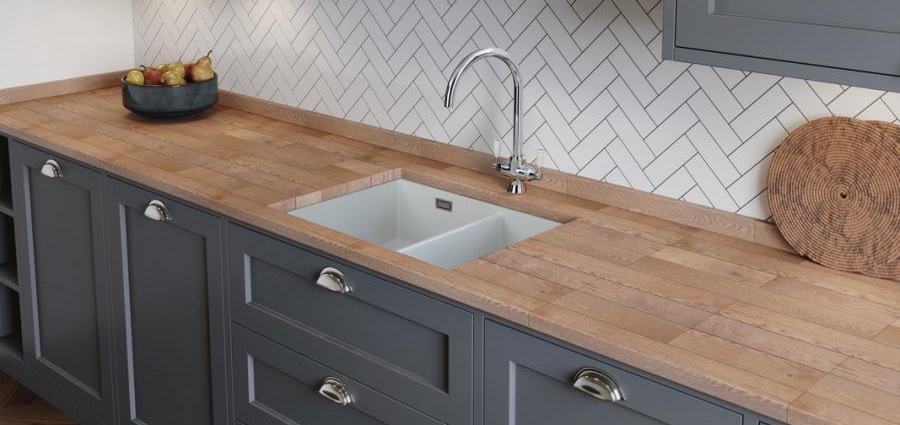Kitchen Sink Types
Reading time: 5 minutes
What types of kitchen sinks are there?
Kitchen sinks usually fall into two main categories. These are undermount sinks and inset sinks. They both have their pros and cons based on price, practicality and aesthetics. You may find that one type of sink will work better with your kitchen layout than another, but it’s good to consider the benefits of either, as it’s easy to overlook benefits and disadvantages.
What are inset sinks?
Inset sinks (also known as overmount, top-mount or drop-in sinks) are possibly the most recognisable kitchen sink in the UK. As the ‘drop-in’ name suggests, they are placed in the hole in the kitchen worktop. The rim or lip of the sink sits over the edge of the work surface.
Inset sinks are broadly available in stainless steel, ceramic and composite, and can vary in cost depending on the size and materials used. When it comes to sizes, inset sinks tend to have a draining board included and, if there’s space, a second, smaller bowl, which we’ll come on to later.
What is an undermount sink?
There’s something quite traditional about an undermount sink. The style has been around for a very long time, and they have an appeal for those of us who enjoy the look of a country or rustic kitchen.
However, they also look perfectly at home in contemporary kitchens, and work well with industrial décor, such as exposed brick. Unlike an inset sink that is easily placed and installed on the top of a counter, an undermount sink requires more of a specialist installation. These sinks will often need far more depth for installation as they rest on a board and fixed either by bolting or glued with epoxy for stability.

Do I need a draining board?
Draining boards come in handy if you don’t have a dishwasher, making life a little easier by leaving washing out to dry. By adding a chopping board, you can use a draining board as additional worktop space. Essentially if you have an issue with space and need a kitchen solution for it, a draining board can help a little.
Do I need a second sink bowl?
A second sink bowl can be handy for a few reasons. When washing dishes in one sink, you can separate more delicate items into the other one, reducing breakages. Alternatively, if you need to rinse vegetables, you can do this separately in the smaller bowl to keep any dirt away from the main sink.
What are kitchen sinks made of?
The sheer variety of materials used for kitchen sinks today suits every style of décor and personal taste you can imagine. Thanks to modern innovations, we can go beyond ceramic and stainless steel and explore more materials.
- Ceramic Kitchen Sinks
- Composite Sinks
- Stainless Steel Kitchen Sinks
- What is a Linen Stainless Steel Sink?
For more kitchen inspiration, take a look at the help and advice on Trade Corner. We’re here to offer expert tips from home and garden to industry information.
Disclaimer: The information contained on this page is intended as an overall introduction and is not intended as specific advice from a qualified professional. Travis Perkins aims to avoid, but accepts no liability, in the case that any information stated is out of date.
Always refer to the manufacturer's guidance and installation instructions.




